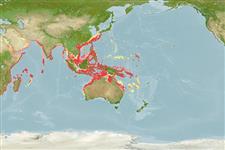Common names from other countries
分類 / Names
共通名の | 類義語 | Catalog of Fishes(部類, 種) | ITIS | CoL | WoRMS | Cloffa
Environment: milieu / climate zone / depth range / distribution range
生態学
海; 汽水性の 関連する礁; 深さの範囲 50 - 200 m (Ref. 47690). Subtropical; 32°N - 30°S, 30°E - 169°E
Indo-West Pacific: East Africa, as far south as Durban in South Africa, to southern Japan and northeastern Australia, east to New Caledonia.
Length at first maturity / サイズ / 重さ / 年齢
Maturity: Lm 14.0 range ? - ? cm
Max length : 30.0 cm TL オス/雌雄の選別がない; (Ref. 47690); common length : 20.0 cm TL オス/雌雄の選別がない; (Ref. 47690)
背面の脊椎 (合計) : 3 - 4; 背鰭 (合計) : 40 - 45; 肛門の骨: 0; 臀鰭: 30 - 33. This species is distinguished by its very deep body, almost triangular, extremely compressed; sharp-edged breast; greatest body depth below lateral line at least 4 times greater than greatest body depth above lateral line; anal fin very long-based, commencing at point of insertion of pelvic fins, uniformly very low; dorsal spines (X in juveniles) reducing in number with increasing age. Colour of body with upper sides deep metallic blue, the rest silvery, a row of round to ovoid, dark slaty-blue spots above and below lateral line, sometimes a few additional spots above and below these rows; pelvic fins with a trace of blue, other fins hyaline or slightly dusky (Ref. 47690).
Inhabits deeper coastal waters near the bottom on both the continental shelves and around major island groups; sometimes in river estuaries (Ref. 47690, 48635). Found in schools (Ref. 47690, 48635). Feeds on benthic invertebrates (Ref. 5213). Readily dries in air without salting (Ref. 4375, 48635). Caught in trawls and by beach seine, but mainly by trawling, often incidentally. Marketed fresh and dried (Ref. 47690). Minimum depth from Ref. 30573.
Life cycle and mating behavior
Maturities | 繁殖 | Spawnings | Egg(s) | Fecundities | 幼生
Heemstra, P.C., 1984. Menidae. In W. Fischer and G. Bianchi (eds.) FAO species identification sheets for fishery purposes. Western Indian Ocean fishing area 51. Vol. 3. (Ref. 3465)
CITES (Ref. 128078)
Not Evaluated
Human uses
水産業: 商業
用具
特記事項
XMLをダウンロードして下さい
インターネットの情報源
Estimates based on models
Preferred temperature (Ref.
115969): 19.8 - 27.6, mean 24.4 (based on 503 cells).
Phylogenetic diversity index (Ref.
82804): PD
50 = 1.5000 [Uniqueness, from 0.5 = low to 2.0 = high].
Bayesian length-weight: a=0.02089 (0.00843 - 0.05176), b=3.04 (2.82 - 3.26), in cm Total Length, based on LWR estimates for this (Sub)family-body shape (Ref.
93245).
栄養段階 (Ref.
69278): 3.5 ±0.41 se; based on food items.
回復力 (Ref.
120179): 高い, 15か月以下の倍増期間の最小個体群 (K=0.19-1.2).
Fishing Vulnerability (Ref.
59153): Low vulnerability (17 of 100).
Climate Vulnerability (Ref.
125649): Low to moderate vulnerability (33 of 100).
